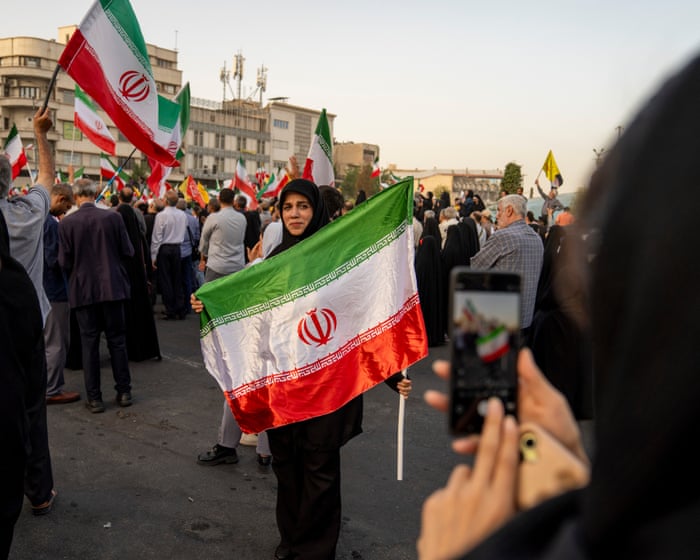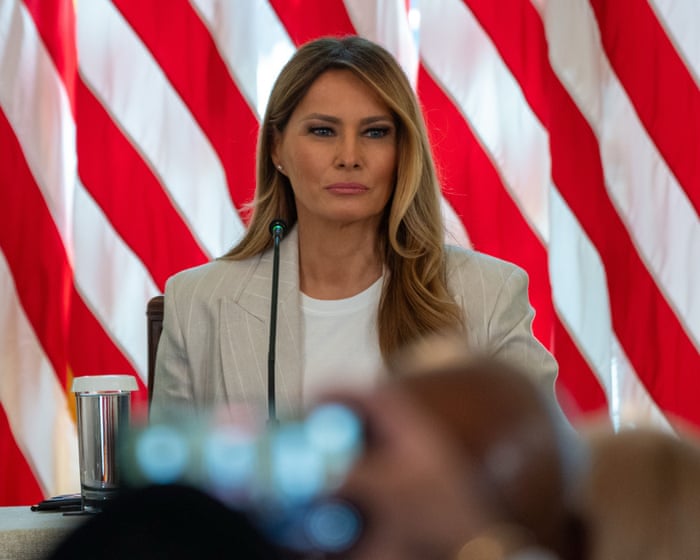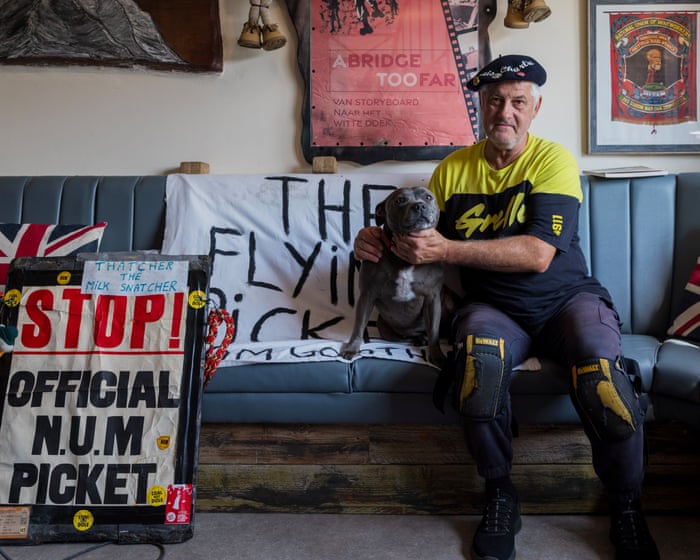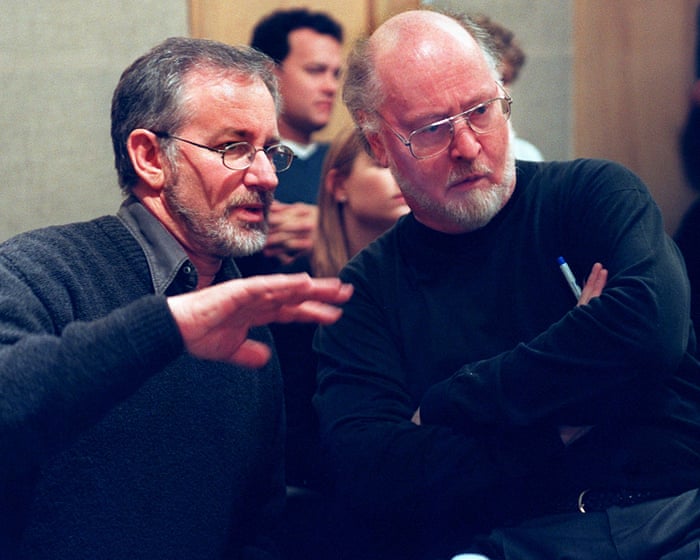Workers are now demolishing the ruins of what was once the Tehran home of Iranian nuclear scientist Ahmadreza Zolfaghari. The building was destroyed beyond repair in a surprise Israeli attack targeting Iran’s political, military, and nuclear figures. Zolfaghari, who worked at the Faculty of Nuclear Engineering at Shahid Beheshti University and edited a nuclear energy journal, was killed in the strike along with his wife and adult son. Three neighboring buildings were also destroyed, killing at least five more people, including an 11-year-old child. A blue banner hanging on one damaged building reads: “A piece of the body of Iran.”
The demolition crew moves carefully across unstable floor beams, swinging sledgehammers to bring down the remains of the structure. Loose bricks and debris crash to the ground, filling the air with dust. Their dangerous work—standing on creaking beams as they hammer—reflects a country still in shock, neither at peace nor at war, but in need of rebuilding.
More than 1,000 Iranians died in the Israeli attack, and some sociologists—a broad term in Iran—argue that a new sense of nationalism has become visible.
Outwardly, Tehran is changing quickly, and socially it is far from Western perceptions. About a third of women on Tehran’s streets no longer wear the hijab, and it’s not just young women—sometimes entire families go uncovered. A new chastity law pushed by religious conservatives, who still dominate parliament, was rejected by the reformist president, Masoud Pezeshkian, on the practical grounds that enforcing it could spark unrest.
The law’s failure has emboldened women. Police, who once arrested those deemed “unchaste,” now often leave uncovered women alone. The lively, if polluted, evening streets feel more like Beirut than Kabul. The next step may be allowing women to ride motorcycles. Observers note that Mahsa Amini, the young Kurdish woman whose death in police custody in 2022 sparked the “woman, life, freedom” protests, did not die entirely in vain.
Cultural sociologist Nematollah Fazeli, a graduate of SOAS, suggests a deeper shift may be underway. He points to an “everyday nationalism” reflected in renewed interest in epic poetry, popular podcasts on Iranian history, and countless everyday conversations about Iranian identity.
Fazeli explains: “Before the war, we loved Iran, but it wasn’t a very conscious feeling. After the war, it became central to our discourse. Everywhere—cities and villages—people are talking about their nation, identity, geography, and history. We want to remind each other we are Iranian. The sense that Iran—our nation, land, culture, and feelings—is oppressed by a global system and foreign powers was very important. It created a desire to come together and express our shared Iranian identity.”
But he adds: “The ideology of the Islamic Republic is not nationalist. The official revolutionary ideology does not emphasize ancient Iranian culture, which is absent from official education, TV, and radio. People’s reaction to the war was one of shock and negative cohesion. Despite frustration with the government, they stood against foreign aggression—not to defend the Islamic Republic, but to defend Iran. We believe we have always been an organic nation.”For more than 5,000 years, Iran has endured. Mohammad Faze, a teacher, noted that his students have been displaying the Iranian flag on their social media profiles. Others highlight the growing number of podcasts exploring Iranian history and the expressions of national pride from popular singers—including former critics of the regime, such as Homayoun Shajarian.
A young Iranian woman was recently photographed holding the national flag while attending a live concert at Azadi Square in western Tehran.
Some government officials have acknowledged the challenge presented by this surge of patriotism. Abdolkarim Hosseinzadeh, the vice-president for rural affairs, told journalists: “Iran is beautiful when we stand together. My closest friends come from diverse backgrounds—Persians, Turks, Kurds, and Baloch. We have lived together, loved one another, and shared our lives. We may not always agree or share the same beliefs, but in Iran, there is no question about our friendship, our patriotism, or our love for this land.”
The current debate in Iran centers on how—or whether—the government should respond to the resilience shown by its people under pressure, or what foreign affairs spokesperson Esmaeil Baghaee referred to as a “blitz spirit.”
Even brief wars can transform nations. Aliakbar Velayati, an adviser to Iran’s supreme leader, argued: “The people have proven themselves; now it is the officials’ turn. Outdated methods will no longer work for a society that has lived through war.”
However, translating these broad ideas into action is difficult in a deeply divided and politicized society. Even Shajarian’s plan to hold a free open-air concert in Tehran’s Azadi Square this weekend fell apart amid political disputes over whether the event was meant as simple relief or as propaganda.
Conservatives believe the social unity unintentionally strengthened by Benjamin Netanyahu’s misguided attempt at regime change from the air confirms the supreme leader’s popularity and Iran’s ideological foreign policy.
But many reformists caution against interpreting everyday patriotism as support for the Islamic Republic or the status quo. One reformist asked: “How can we be complacent when the currency has fallen 25% in a week, poverty is widespread, official media spreads lies, and no one knows if another war is coming?”
Reformists hope for what former foreign minister Mohammad Javad Zarif called a “paradigm shift.” In recent weeks, former prime minister Mir-Hossein Mousavi—under house arrest for 15 years and now hospitalized—issued an open letter calling for a new constitution. The Reform Front, an umbrella group of moderate and reformist figures, urged the government to take steps long demanded by the U.S., such as voluntarily suspending domestic uranium enrichment in exchange for sanctions relief.
Former two-term president Hassan Rouhani also weighed in, advocating for a “national strategy based on the will of the people.” He said the crisis should serve as an opportunity to correct course and rebuild governance. Rouhani called for establishing a grassroots intelligence agency, empowering scientists to modernize Iran’s defenses, diversifying media through private television channels, and improving Iran’s strained relations with the world—including reducing hostility toward the U.S.
Beyond politicians, 180 economists urged a restructuring of Iran’s economic and political paradigms, including removing the military from business. Seventy-eight former diplomats pressed for a foreign policy that acts without delay to lift sanctions.
“Give diplomacy a chance,” they argue. But resistance remains.Resistance to change. The influence of Iran’s security forces has resulted in a crackdown, including roadblocks and up to 20,000 arrests, according to Amnesty International.
Conservatives quickly passed a harsh law allowing authorities to censor online content. The head of the judiciary, Gholam-Hossein Mohseni-Eje’i, condemned a Reform Group statement that criticized the move, calling it “in line with the enemy’s wishes.” He added that “it would be natural for the Tehran prosecutor to take an interest in such statements,” a remark clearly intended to intimidate reformists.
Faced with these persistent tensions, President Pezeshkian tends to avoid confrontation, sometimes frustrating the reformists who helped elect him in a surprising victory just a year ago. He is acutely aware of his limited power: conservative forces are determined to undermine him, he depends on the supreme leader, and a deep state fiercely protects its privileges. Last week, he admitted that the polarized nature of Iranian politics worries him as much as sanctions do.
He has made consensus his guiding principle, to the extent that Mohsen Asgari, editor of the innovative media outlet Haft Sobh, warns: “The risk is that he turns a method of government—the search for consensus—into an objective.”
Government spokesperson Fatemeh Mohajerani, who studied at Heriot-Watt University, defends Pezeshkian’s focus on persuasion and problem-solving. She points out that building consensus on complex social issues in a divided society takes time, and the separation of powers prevents him from calling for the release of political prisoners. She insists progress is being made, such as efforts to lift bans on external social media platforms like Telegram, X, and even Instagram. A planned visit by Telegram executives to discuss their operations in Iran was only halted by the outbreak of war, she noted. When asked if the government should apologize for the deaths and injuries of women fighting for freedom, she replied that the government will apologize when necessary.
Pezeshkian’s ability to pursue economic reforms is constrained by widespread public anger over the 12-day war and the threat of renewed UN sanctions. Many Iranians, reformist or not, believe Europe is effectively endorsing Israel’s illegal bombing campaign by moving toward snapback sanctions.
Anger that the U.S. allowed or tacitly supported the bombing during negotiations, while Europe failed to condemn it, has deepened distrust and strengthened anti-Western factions. Reza Nasri, an international lawyer close to the reformists, said: “Before the war, people worried Trump might withdraw from any agreement; now they fear he will bomb us. It’s very hard to argue within Iran that negotiations are beneficial or will lead to sanctions relief.
The perception is that Trump has handed over Iran policy to Israel. People feel, ‘We went to negotiate and got bombs—why should we try again?’ It would be politically costly for any government to return to talks. If Europe wants that, they’ve gone about it the wrong way. Imposing snapback sanctions will likely lead Iran to exclude Europe from future negotiations and bar UN weapons inspectors. The logical step for Europe is to delay snapback and give diplomacy a chance.”
Nasri added: “The issue of Iran’s right to enrich uranium domestically—supposedly the cause of the conflict—is not about building a bomb, deterrence, or even nuclear energy. It’s about retaining a symbol of dignity.”Standing in the courtyard of the Hemmat Tajrish mosque, near the graves of those who died in the 12-day war, Mohammad Faze acknowledges that Iranian society has been living on edge. Still, he insists, “I’m not the type to be completely certain about anything, but if this war returns, we will be ready. We learned from the 12-day war, and we are prepared. It is deeply ingrained in the Iranian spirit that we will not surrender, and we will not be humiliated.”
Frequently Asked Questions
Of course Here is a list of FAQs about The people rose up how war shaped Irans shift toward everyday nationalism
BeginnerLevel Questions
1 What is everyday nationalism in the context of Iran
It refers to a sense of national identity and pride that is rooted in the daily lives shared struggles and cultural traditions of ordinary Iranians rather than just the official state ideology
2 Which war is this referring to
The IranIraq War also known as the Imposed War in Iran
3 How did a war lead to nationalism
The war created a shared experience of sacrifice and resistance for millions of Iranians Defending the country against an invasion fostered a powerful unified sense of being Iranian that transcended politics
4 Is this different from the governments official nationalism
Yes The government promotes a statecentric ideological nationalism often tied to the 1979 Revolution and Islamic values Everyday nationalism is more organic focusing on the people their history and their perseverance
5 Can you give an example of everyday nationalism
A common example is the deep cultural reverence for martyrs of the IranIraq War and their families This isnt just a government narrative its a genuine widespread public sentiment woven into the social fabric
Intermediate Advanced Questions
6 Didnt the war solidify the new Islamic Republics power How did that create a separate nationalism
While the government used the war to consolidate its power the experience on the ground for citizens created a parallel identity People were fighting for their homes families and the very soil of Iran which created a national bond that existed alongside and sometimes independent of their support for the government
7 What role did media and art play in shaping this
War films music and literature often focused on human stories of soldiers and civilianstheir love for their country their sorrow and their resilience This helped craft a national narrative centered on the peoples experience not just state propaganda
8 How does everyday nationalism manifest in Iran today
It can be seen in strong displays of national pride during sports events in the preservation of ancient Persian traditions and in a general defiance against external pressures




